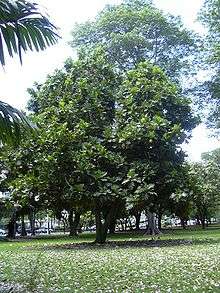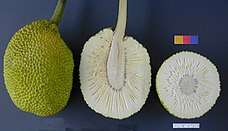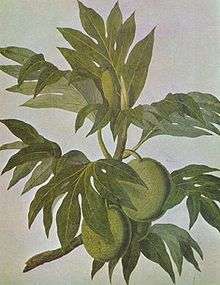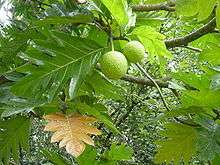Breadfruit
Breadfruit (Artocarpus altilis) is a species of flowering tree in the mulberry and jackfruit family (Moraceae) believed to be a domesticated descendant of Artocarpus camansi originating in New Guinea, the Maluku Islands, and the Philippines. It was initially spread to Oceania via the Austronesian expansion. It was further spread to other tropical regions of the world during the Colonial Era.[2][3] British and French navigators introduced a few Polynesian seedless varieties to Caribbean islands during the late 18th century. Today it is grown in some 90 countries throughout South and Southeast Asia, the Pacific Ocean, the Caribbean, Central America and Africa.[4] Its name is derived from the texture of the moderately ripe fruit when cooked, similar to freshly baked bread and having a potato-like flavor.[4][5]
| Breadfruit | |
|---|---|
.jpg) | |
| Breadfruit at Tortuguero, Costa Rica | |
| Scientific classification | |
| Kingdom: | Plantae |
| Clade: | Tracheophytes |
| Clade: | Angiosperms |
| Clade: | Eudicots |
| Clade: | Rosids |
| Order: | Rosales |
| Family: | Moraceae |
| Genus: | Artocarpus |
| Species: | A. altilis |
| Binomial name | |
| Artocarpus altilis (Parkinson) Fosberg | |
| Synonyms | |
| |
The trees have been widely planted in tropical regions, including lowland Central America, northern South America, and the Caribbean.[3][4] In addition to the fruit serving as a staple food in many cultures, the light, sturdy timber of breadfruit has been used for outriggers, ships, and houses in the tropics.
Breadfruit is closely related to Artocarpus camansi (breadnut or seeded breadfruit) of New Guinea, the Maluku Islands, and the Philippines, Artocarpus blancoi (tipolo or antipolo) of the Philippines, and Artocarpus mariannensis (dugdug) of Micronesia, all of which are sometimes also referred to as "breadfruit". It is also closely related to Artocarpus heterophyllus (jackfruit).[6]
History
According to DNA fingerprinting studies, the wild seeded ancestor of breadfruit is the breadnut (Artocarpus camansi) which is native to New Guinea, the Maluku Islands, and the Philippines. It was one of the canoe plants spread by Austronesian voyagers around 3,000 years ago into Micronesia, Melanesia, and Polynesia, where it was not native.[2][7][6][8]
.png)
A. camansi was domesticated and selectively bred in Polynesia, giving rise to the mostly seedless Artocarpus altilis. Micronesian breadfruit also show evidence of hybridization with the native Artocarpus mariannensis, while most Polynesian and Melanesian cultivars do not. This indicates that Micronesia was initially colonized separately from Polynesia and Melanesia through two different migration events which later came into contact with each other in eastern Micronesia.[2][7][6][8][4][5]
Sir Joseph Banks and others saw the value of breadfruit as a highly productive food in 1769, when stationed in Tahiti as part of the Endeavour expedition commanded by Captain James Cook.[5][9] The late-18th-century quest for cheap, high-energy food sources for slaves in British colonies prompted colonial administrators and plantation owners to call for the plant to be brought to the Caribbean. As president of the Royal Society, Banks provided a cash bounty and gold medal for success in this endeavor, and successfully lobbied his friends in government and the Admiralty for a British Naval expedition. In 1787, William Bligh was appointed captain of HMS Bounty, and ordered to proceed to the South Pacific to collect the plants. In 1791, Bligh commanded a second expedition with Providence and Assistant, which collected seedless breadfruit plants in Tahiti and transported these to St. Helena, in the Atlantic, and St. Vincent and Jamaica in the West Indies.[4][5] Although Bligh won the Royal Society medal for his efforts, the introduction was not entirely successful, as most slaves refused to eat the new food.[10]
Description

Breadfruit trees grow to a height of 26 m (85 ft).[3] The large and thick leaves are deeply cut into pinnate lobes. All parts of the tree yield latex,[3] which is useful for boat caulking.[5]
The trees are monoecious, with male and female flowers growing on the same tree. The male flowers emerge first, followed shortly afterward by the female flowers. The latter grow into capitula, which are capable of pollination just three days later. Pollination occurs mainly by fruit bats, but cultivated varieties produce fruit without pollination.[5] The compound, false fruit develops from the swollen perianth, and originates from 1,500-2,000 flowers visible on the skin of the fruit as hexagon-like disks.
Breadfruit is one of the highest-yielding food plants, with a single tree producing up to 200 or more grapefruit-sized fruits per season, requiring limited care. In the South Pacific, the trees yield 50 to 150 fruits per year, usually round, oval or oblong weighing 0.25–6 kg.[4] Productivity varies between wet and dry areas. Studies in Barbados indicate a reasonable potential of 16–32 short tons per hectare (6.5–12.9 short ton/acre).[3] The ovoid fruit has a rough surface, and each fruit is divided into many achenes, each achene surrounded by a fleshy perianth and growing on a fleshy receptacle. Most selectively bred cultivars have seedless fruit, whereas seeded varieties are grown mainly for their edible seeds.[5] Breadfruit is usually propagated using root cuttings.[4]
Breadfruit is closely related to the breadnut, from which it might have been naturally selected.[4] It is noticeably similar in appearance to its relative of the same genus, the jackfruit (Artocarpus heterophyllus).
Breadfruit has hundreds of varieties and thousands of common names varying according to its geographic distribution, and is cultivated in some 90 countries.[3][4]
The closely related Artocarpus camansi can be distinguished from A. altilis by having spinier fruits with numerous seeds. Artocarpus mariannensis can be distinguished by having dark green elongated fruits with darker yellow flesh, as well as entire or shallowly lobed leaves.[6]
Habitat
Breadfruit is an equatorial lowland species. It grows best below elevations of 650 metres (2,130 ft), but is found at elevations of 1,550 metres (5,090 ft). Preferred soils are neutral to alkaline (pH of 6.1–7.4) and either sand, sandy loam, loam or sandy clay loam. Breadfruit is able to grow in coral sands and saline soils. The breadfruit is ultra-tropical, requiring a temperature range of 16–38 °C (61–100 °F) and an annual rainfall of 200–250 cm (80–100 in).[3]
Nutrition
| Nutritional value per 100 g (3.5 oz) | |
|---|---|
| Energy | 431 kJ (103 kcal) |
27.12 g | |
| Sugars | 11 g |
| Dietary fiber | 4.9 g |
0.23 g | |
1.07 g | |
| Vitamins | Quantity %DV† |
| Vitamin A equiv. | 22 μg |
| Thiamine (B1) | 10% 0.11 mg |
| Riboflavin (B2) | 3% 0.03 mg |
| Niacin (B3) | 6% 0.9 mg |
| Pantothenic acid (B5) | 9% 0.457 mg |
| Vitamin B6 | 8% 0.1 mg |
| Folate (B9) | 4% 14 μg |
| Choline | 2% 9.8 mg |
| Vitamin C | 35% 29 mg |
| Vitamin E | 1% 0.1 mg |
| Vitamin K | 0% 0.5 μg |
| Minerals | Quantity %DV† |
| Calcium | 2% 17 mg |
| Iron | 4% 0.54 mg |
| Magnesium | 7% 25 mg |
| Manganese | 3% 0.06 mg |
| Phosphorus | 4% 30 mg |
| Potassium | 10% 490 mg |
| Sodium | 0% 2 mg |
| Zinc | 1% 0.12 mg |
| Other constituents | Quantity |
| Water | 70.65 g |
| |
| †Percentages are roughly approximated using US recommendations for adults. Source: USDA Nutrient Database | |
Breadfruit is 71% water, 27% carbohydrates, 1% protein and negligible in fat (see table). In a 100 gram amount, raw breadfruit is a rich source (35% of the Daily Value, DV) of vitamin C, and a moderate source (10% DV each) of thiamin and potassium, with no other nutrients in significant content.
Uses


Food
_slices%2C_Philippines.jpg)
Breadfruit is a staple food in many tropical regions. Most breadfruit varieties produce fruit throughout the year. Both ripe and unripe fruit have culinary uses; unripe breadfruit is cooked before consumption.[11] Before being eaten, the fruit are roasted, baked, fried or boiled. When cooked, the taste of moderately ripe breadfruit is described as potato-like, or similar to freshly baked bread.
One breadfruit tree can produce 450 pounds (200 kg) each season.[12] Because breadfruit trees usually produce large crops at certain times of the year, preservation of harvested fruit is an issue. One traditional preservation technique is to bury peeled and washed fruits in a leaf-lined pit where they ferment over several weeks and produce a sour, sticky paste. So stored, the product may endure a year or more, and some pits are reported to have produced edible contents more than 20 years later.[13] Fermented breadfruit mash goes by many names such as mahr, ma, masi, furo, and bwiru, among others.
Breadfruit can be eaten once cooked, or can be further processed into a variety of other foods. A common product is a mixture of cooked or fermented breadfruit mash mixed with coconut milk baked in banana leaves. Whole fruits can be cooked in an open fire, then cored and filled with other foods, such as coconut milk, sugar and butter, cooked meats, or other fruits. The filled fruit can be cooked further so the flavor of the filling permeates the flesh of the breadfruit.
Southeast Asia and Pacific Islands
The seedless breadfruit is found in Brunei, Indonesia and Malaysia, where it is called sukun. It is commonly made into fritters and eaten as snacks. Breadfruit fritters are sold as local street food.
In the Philippines, breadfruit is known as rimas in Tagalog and kolo in the Visayan languages. It is also called kamansi (also spelled camansi), along with the closely related Artocarpus camansi, and the endemic Artocarpus blancoi (tipolo or antipolo). All three species, as well as the closely related jackfruit, are commonly used much in the same way in savory dishes. The immature fruits are most commonly eaten as ginataang rimas (cooked with coconut milk).[14][15][16][6][8]
In the Hawaiian staple food called poi, the traditional ingredient of mashed taro root can be replaced by, or augmented with, mashed breadfruit. The resulting "breadfruit poi" is called poi ʻulu.
South Asia
In Sri Lanka, it is cooked as a curry using coconut milk and spices (which becomes a side dish) or boiled. Boiled breadfruit is a famous main meal. It is often consumed with scraped coconut or coconut sambol, made of scraped coconut, red chili powder and salt mixed with a dash of lime juice. A traditional sweet snack made of finely sliced, sun-dried breadfruit chips deep-fried in coconut oil and dipped in heated treacle or sugar syrup is known as rata del petti.[17] In India, fritters of breadfruit, called jeev kadge phodi in Konkani or kadachakka varuthath in Malayalam are a local delicacy in coastal Karnataka and Kerala. In Seychelles, it was traditionally eaten as a substitute for rice, as an accompaniment to the mains. It would either be consumed boiled (friyapen bwi) or grilled (friyapen griye), where it would be put whole in the wood fire used for cooking the main meal and then taken out when ready. It is also eaten as a dessert, called ladob friyapen, where it is boiled in coconut milk, sugar, vanilla, cinnamon and a pinch of salt.
Caribbean and Latin America
In Belize, the Mayan people call it masapan.
In Puerto Rico, breadfruit is called panapen or pana, for short, although the name pana is often used to refer to breadnut, seeds of which have traditionally been boiled, peeled and eaten whole. In some inland regions it is also called mapén. Breadfruit is often served boiled with a mixture of sauteed bacalao (salted cod fish), olive oil and onions. Mostly as tostones where about 1 inch chunks are fried, lighty flattered and fried again. Mofongo de pana fried breadfruit mashed with olive oil, garlic, broth, and chicharrón. Ripe breadfruit is used in desserts: flan de pana (breadfruit custard) and ice cream (Lares Ice Cream Parlor).
In the Dominican Republic, it is called buen pan or "good bread".
In Barbados, breadfruit is boiled with salted meat and mashed with butter to make breadfruit coucou. It is usually eaten with saucy meat dishes.
In Jamaica, breadfruit is boiled in soups or roasted on stove top, in the oven or on wood coal. It is usually eaten with the national dish ackee and salt fish. The ripe fruit is used in salads or fried as a side dish.
Timber and other uses
Breadfruit was widely used in a variety of ways among Pacific Islanders. Its lightweight wood (specific gravity of 0.27)[18] is resistant to termites and shipworms, so it is used as timber for structures and outrigger canoes.[4] Its wood pulp can also be used to make paper, called breadfruit tapa.[4] Native Hawaiians used its sticky latex to trap birds, whose feathers were made into cloaks.[3] The wood of the breadfruit tree was one of the most valuable timbers in the construction of traditional houses in Samoan architecture.
Breadfruit contains phytochemicals having potential as an insect repellent.[19][20] The parts of the fruits that are discarded can be used to feed livestock. The leaves of breadfruit trees can also be browsed by cattle.[21]
In culture
On Puluwat in the Caroline Islands, in the context of sacred yitang lore, breadfruit (poi) is a figure of speech for knowledge. This lore is organized into five categories: war, magic, meetings, navigation, and breadfruit.[22]
According to an etiological Hawaiian myth, the breadfruit originated from the sacrifice of the war god Kū. After deciding to live secretly among mortals as a farmer, Kū married and had children. He and his family lived happily until a famine seized their island. When he could no longer bear to watch his children suffer, Kū told his wife that he could deliver them from starvation, but to do so he would have to leave them. Reluctantly she agreed, and at her word, Kū descended into the ground right where he had stood until only the top of his head was visible. His family waited around the spot he had last been, day and night, watering it with their tears until suddenly, a small green shoot appeared where Kū had stood. Quickly, the shoot grew into a tall and leafy tree that was laden with heavy breadfruits that Kū's family and neighbors gratefully ate, joyfully saved from starvation.[23]
Though they are widely distributed throughout the Pacific, many breadfruit hybrids and cultivars are seedless or otherwise biologically incapable of naturally dispersing long distances. Therefore, it is clear that humans aided distribution of the plant in the Pacific, specifically prehistoric groups who colonized the Pacific Islands. To investigate the patterns of human migration throughout the Pacific, scientists have used molecular dating of breadfruit hybrids and cultivars in concert with anthropological data. Results support the west-to-east migration hypothesis, in which the Lapita people are thought to have traveled from Melanesia to numerous Polynesian islands.[7]
The world's largest collection of breadfruit varieties was established by botanist Diane Ragone, from over 20 years' travel to 50 Pacific islands, on a 10-acre (4.0-hectare) plot outside of Hana, on the isolated east coast of Maui (Hawaii).[24]
Propagation
Breadfruit is propagated mainly by seeds, although seedless breadfruit can be propagated by transplanting suckers that grow off the surface roots of the tree.[3] The roots can be purposefully injured to induce the growth of suckers, which are then separated from the root and planted in a pot or directly transplanted into the ground.[3] Pruning also induces sucker growth.[3] Sucker cuttings are placed in plastic bags containing a mixture of soil, peat and sand, and kept in the shade while moistened with liquid fertilizer. When roots are developed, the transplant is put in full sun until time for planting in the orchard.[3]
For propagation in quantity, root cuttings are preferred, using segments about 2 inches (5.1 cm) thick and 9 inches (23 cm) long.[3] Rooting may take up to 5 months to develop, with the young trees ready for planting when they are 2 feet (61 cm) high.[3]
Gallery
 Drawing of breadfruit by John Frederick Miller
Drawing of breadfruit by John Frederick Miller Breadfruit in Mangalore
Breadfruit in Mangalore Artocarpus altilis in Hawai'i
Artocarpus altilis in Hawai'i- A polished basalt breadfruit pounder
See also
References
- "Artocarpus altilis (Parkinson ex F.A.Zorn) Fosberg – The Plant List". The Plant List. Retrieved 2016-01-12.
- Matisoo-Smith, Elizabeth A. (3 November 2015). "Tracking Austronesian expansion into the Pacific via the paper mulberry plant". Proceedings of the National Academy of Sciences. 112 (44): 13432–13433. doi:10.1073/pnas.1518576112. PMC 4640783. PMID 26499243.
- Morton, Julia F (1987). "Breadfruit; In: Fruits of Warm Climates". NewCROP, the New Crop Resource Online Program, Center for New Crops and Plant Products, Department of Horticulture and Landscape Architecture, Purdue University, West Lafayette, IN. pp. 50–58. Archived from the original on 5 January 2015. Retrieved 17 January 2017.
- "Breadfruit Species". National Tropical Botanical Garden - Tropical Plant Research, Education, and Conservation. 2017. Retrieved 17 January 2017.
- "Artocarpus altilis (breadfruit)". Board of Trustees of the Royal Botanic Gardens, Kew Gardens, Richmond, Surrey, UK. 2017. Retrieved 17 January 2017.
- Ragone, Diane (April 2006). Elevitch, C.R. (ed.). "Artocarpus camansi (breadfruit), ver.2.1" (PDF). Species Profiles for Pacific Island Agroforestry. Hōlualoa, Hawai‘i: Permanent Agriculture Resources (PAR). Retrieved 18 April 2012. <http://www.traditionaltree.org>.
- Zerega, N. J. C.; Ragone, D. & Motley, T.J. (2004). "The complex origins of breadfruit (Artocarpus altilis, Moraceae): Implications for human migrations in Oceania". American Journal of Botany. 91 (5): 760–766. doi:10.3732/ajb.91.5.760. PMID 21653430.
- Ragone, Diane (2011). "Farm and Forestry Production and Marketing Profile for Breadfruit (Artocarpus altilis)". In Elevitch, Craig R. (ed.). Specialty Crops for Pacific Island Agroforestry. Hōlualoa, Hawai‘i: Permanent Agriculture Resources. ISBN 978-0970254481.
- Salmond, Anne (2010). Aphrodite's Island. Berkeley: University of California Press. pp. 190, 197, 307–308. ISBN 9780520261143.
- O'Brian, Patrick (8 December 1997). Joseph Banks: A Life. University of Chicago Press. ISBN 978-0-226-61628-5.
- Janick, Jules; Paull, Robert E. (2008). The Encyclopedia of Fruit and Nuts. CABI. p. 476. ISBN 978-0-85199-638-7.
- "'Food of the Future' Has One Hitch: It's All But Inedible". Wall Street Journal. November 1, 2011. Retrieved 6 August 2019.
- Balick, Michael J.; Cox, Paul Alan (1997). Plants, People, and Culture: The Science of Ethnobotany. Scientific American Library. ISBN 978-0-7167-6027-6.
- "Kamansi/Breadnuts: A Local Food Alternative". Love Mindanao. Retrieved 13 January 2019.
- "Kamansi". Specialty Produce. Retrieved 13 January 2019.
- "Kamansi / Seeded Breadfruit (Revisited)". Market Manila. Retrieved 13 January 2019.
- Apé Lamā Lōkaya:1950, Chapter 31 (Vijitha Yapa Publications) ISBN 978-955-665-250-5
- Little Jr., Elbert L.; Roger G. Skolmen (1989). "ʻUlu, breadfruit" (PDF). United States Forest Service. Archived from the original (PDF) on 30 October 2014. Cite journal requires
|journal=(help) - A. Maxwell P. Jones; Jerome A. Klun; Charles L. Cantrell; Diane Ragone; Kamlesh R. Chauhan; Paula N. Brown & Susan J. Murch (2012). "Isolation and Identification of Mosquito (Aedes aegypti) Biting Deterrent Fatty Acids from Male Inflorescences of Breadfruit (Artocarpus altilis (Parkinson) Fosberg)". Journal of Agricultural and Food Chemistry. 60 (15): 3867–3873. doi:10.1021/jf300101w. PMID 22420541.
- Avant, Susan (15 November 2013). "Studies Confirm Breadfruit's Ability to Repel Insects". US Department of Agriculture. Retrieved 14 June 2016.
- Heuzé, V.; Tran, G.; Hassoun, P.; Bastianelli, D.; Lebas, F. (2017). "Breadfruit (Artocarpus altilis)". Feedipedia, a programme by INRA, CIRAD, AFZ and FAO.
- Riesenberg, Saul H.; Elbert, Samuel H. (1971). "The Poi of the Meeting". Journal of the Polynesian Society, Auckland University.
Kkónen, although literally meaning pounded breadfruit, refers in these bowls of knowledge to work, skills, and stores of information of any kind having to do with secret words and meanings—that is to say, yitang lore. Breadfruit is used here as a figure of speech for knowledge. And the breadfruit of knowledge is contained in all five bowls, even though the names of only three of them include the word for pounded breadfruit, and even though only the last contains knowledge about breadfruit in that word's literal meaning. Thus, the Puluwat people classify yitang information into five categories: war, magic, meetings, navigation, and breadfruit.
Cite journal requires|journal=(help) - Shannon Wianecki (May–June 2013). "Breadfruit". Maui Nō Ka ʻOi Magazine, Haynes Publishing Group. Retrieved 17 January 2017.
- Julia Steele; photos by Jack Wolford (August–September 2009). "Tree of Plenty". Hana Hou!.
External links


- Breadfruit Institute